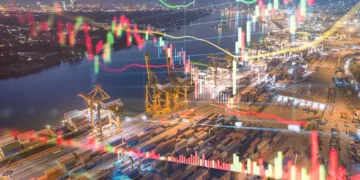The metal industry is a crucial component of India’s infrastructure sector, serving as the foundation for industrial growth and technological innovation, contributing to the nation’s development and economic growth. India is home to substantial mineral reserves, including diverse mineral deposits that are central to the production of various metals.
The Indian economy has been witnessing an ongoing expansion, complemented by the government’s strong focus on infrastructure development. This has led to increased production and consumption of metals. Notably, India ranks as the world’s second-largest producer of crude steel, having achieved a production volume of 124.7 million tonnes in 2022.
India benefits from the indigenous availability of key raw materials like high-grade iron ore, bauxite, zinc ore, and non-coking coal. This, combined with the country’s younger workforce, has provided a competitive edge in manufacturing and a burgeoning presence in the global market.
Export trends in the Indian iron and steel sector have been stable, with a peak export value of $21.1 billion in 2021. Despite a decrease in 2022 due to new export duties and a drop in global demand, export values have stayed above pre-pandemic levels. Aluminium, zinc, and copper have also seen a rise in export values over recent years, indicating the growth potential of these sectors.
India has been a net importer of copper but has managed to maintain a consistent export value, avoiding major fluctuations. Copper exports in 2021 reached a value of $2.3 billion, the highest since 2018, before experiencing a dip in 2022 that still left it at the second-highest value in the past five years.
As international demand for metals like steel is projected to increase, India is poised to enhance its share in the global supply chain. Trade agreements could serve as a means to expand metal exports, especially to emerging economies with growing output.
Challenges in the Indian metal sector include the stability of the supply chain for raw materials critical for metal production. Rising costs and import reliance for raw materials have increased production costs, potentially affecting competitiveness in international markets. For example, the copper industry’s dependency on imported copper concentrate and the steel industry’s reliance on imported coking coal illustrate this issue. Additionally, the energy-intensive nature of aluminium production in India requires a steady coal supply, a significant factor in production costs.
Efforts to secure raw material supplies include the establishment of public sector undertakings to explore and acquire international mines and increased domestic exploration and mining of primary raw materials. These strategies aim to reduce import dependency.
Logistical management poses another challenge, with high transportation costs impacting competitiveness. India’s National Logistics Policy aims to address infrastructure constraints and reduce logistics costs, currently at 14% of GDP, to make exports more competitive.
Sustainability and environmental concerns are also shaping global trade. The European Union’s Carbon Border Adjustment Mechanism, which will impose fees on imports based on carbon emissions, will affect Indian exporters due to relatively high emission intensities. The industry is thus compelled to prioritize decarbonization, exploring alternative fuels and emerging technologies to enhance operational and energy efficiency, reduce costs, and meet sustainability standards.
In conclusion, while the Indian metal industry has advantages and opportunities for growth in the global market, addressing the challenges of raw material supply, logistics, and sustainability is critical for maintaining and increasing competitiveness.
Discover supply chain news insights on The Supply Chain Report. Enhance your international trade knowledge at ADAMftd.com with free tools.
#IndiaMetalIndustry #InfrastructureGrowth #MineralReservesIndia #SteelProduction #IronOreSupply #ManufacturingGrowth #IndianExports #MetalSectorChallenges #SupplyChainStability #NationalLogisticsPolicy #SustainableMetals #Decarbonization #GlobalMetalTrade #CarbonBorderAdjustment #TradeExpansion #IndianEconomy

















